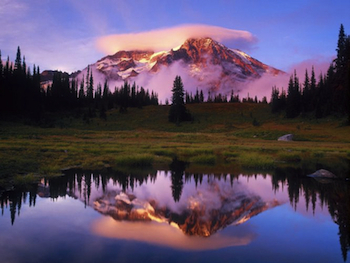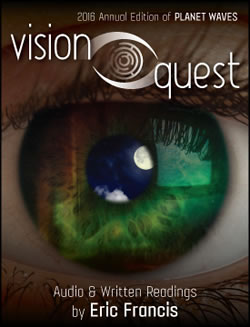By Amanda Moreno
In the past few weeks I have somehow been more productive than at any other time in my history. Ok, that’s probably not entirely true, but my ability to focus and complete concrete tasks has been surreal. Concrete tasks and surreality? Is that the Saturn-Neptune square I hear?

Photo by graywacke/A Landing a Day
Bringing the vision into reality seems to be the order of the day — or of the year, during the course of the transit — and it’s something I’ve taken to heart. The weird part is that the vision feels somewhat nebulous and floaty. I can’t quite pin anything down, but I’m working towards it anyway.
Many of my clients are reporting feeling discombobulated or needing time to integrate whatever the heck happened in 2015 and before. At the same time, they’re feeling like they need to take action immediately. In general, I’ve been advising a little bit of practical planning while the integration period continues through the first two thirds of the year, allowing the new dream to take shape and then acting on it when the astrological forecast turns to more initiating cardinal energy around September. Now is a good time to dream and begin to do little tests, placing stepping-stones that will lead to the dream.
But what are we working for? The Neptune-Saturn square seems to demand that we not tune out from worldly issues, but instead engage our compassion, our presence and our abilities to imagine and then implement ways of healing the world. No pressure.
I’ve been thinking lately about our lack of role models. These thoughts run alongside my regular thoughts about our lack of a coherent mythology. Last week I came across a copy of National Geographic with an image of the Virgin Mary on the cover. Talk about an image of compassion and presence — idol and role model for millions. The headline dubs her “The Most Powerful Woman in the World.” I was curious as to whether that finally meant her darker aspects would be brought out in a mainstream forum — the acknowledgement of the Black Madonna and her reunion with the lighter form at last!
Short version: No, that didn’t happen. Not at all. Except for one caption for an image that depicted a group who worships the Black Madonna.
Longer version: I read the article twice because I knew that my initial read-through was colored by my disdain for the ways the qualities of chastity, purity and selflessness are held as the epitome of the valued, ideal woman, and how much my sadness at what that has come to mean oozes through my pores sometimes. I start to think about the ways those values have been entrenched and have led to such painful and deep repression of the feminine — and of humans — and I get a bit resentful.
Let me digress a bit here to divulge something I don’t really ever talk about, which is that I love the Virgin Mary and have an ongoing relationship with her. She has probably been the most powerful figure I have worked with because of the fact that her healing is so palpable and instantaneous. I have complicated relationships with my guides and the various goddess-types I’ve worked with. My relationship with Mary, however, has always been straightforward: I can feel her presence, I trust her insight; and when it comes down to it, I have asked for her help with physical healing, and the relief has been immediate. I feel a strong connection to that lineage, and she has been the most accessible and reliable figure to have entered my journeying and imaginal work.
The ways that the myth of the goddess got whitewashed and stripped of its complexity in the Judeo-Christian mythologies frustrates the hell out of me, however. One point of view is that the goddess was essentially split into the ‘lighter’ aspects as seen in Mary-as-Virgin, and the ‘darker’ aspects, which went to Mary Magdalene. Mary Magdalene carried the archetype of the sacred prostitute — and for the most part, despite the fact that the Vatican repealed her designation as prostitute years ago, that version of Mary has remained underground. The history of that split is more complex and started well before Christianity, but the Christian myth does a pretty good job of exemplifying it.
Mary Magdalene is there in my imaginal world as well (keeping in mind that, for me, ‘imaginal’ does not mean ‘unreal’ or ‘less real,’ but instead refers to a world where I am tapped into the images my psyche and unconscious are providing, in order to enhance my understanding). Sometimes Mary Magdalene is there as herself, whatever that means; but more often I sense her in the figures of Isis and Aphrodite, who I work with more often.
I’ll end that digression here. So back we go — to my second reading of the National Geographic article. Before reading, I set the intention to sink down into the deepest, truest parts of my being. I suppose this aligns with what others might refer to as linking up with their higher self. I also suppose this linking up was with the part of me who feels ‘whole unto myself’ — a description of Mary cited in the article.
I was struck by the power of the story, as the article focused mainly on the many sightings of Mary over the years, and the power of talismans and icons associated with her. I was in touch with the vastness of her influence and the energy that resonated throughout the article — an acute sense of being whole, centered, and somewhat detached from the world and therefore able to hold a space for love more effectively. It seems an inhuman thing, really — that level of detachment — at least in my experience so far.
Still, though, my concerns and doubts were there. The archetypes embodied and represented by Mary and Jesus, love them as I do (yes, I work with Jesus, too, and believe me it was a shocking day when he showed up as a guide…but, oh the feeling of blissful reunion!), have set the stage for the age of Pisces quite nicely.
We’re nearing the end of that age, however, and as we transition out, the shadows of the Virgo-Pisces dynamic are kickin’. Our call to heal the wounds of the Pisces paradigm seems to have begun to echo with Neptune’s entry to Pisces, and is now being amped with the nodal axis, as well as Saturn joining the fray. Time to release those shadow-Pisces patterns.
The Virgin Mary is a figure who is ‘whole unto herself.’ What a threat, really, in a world in which we’ve been conditioned to be utterly reliant on external validation. In that way, I can see how she is related to the other female goddesses. In a world where “You’re nobody til somebody loves you,” however, that wholeness needs to be tightly controlled. In this case, it is made into a supernatural quality, therefore placing it just out of a mere human’s grasp.
There are other distortions as well. We grapple with the paradox of being totally reliant on externalized value at the same time as many are told also to be whole unto ourselves — in this sense, meaning self-contained in a way that equates asking for help or showing emotion as weak. I think of the image of a woman in high society, who has to look put-together, perfect, untouched by life’s little surprises and sorrows. There is a coldness there that is resonant with the icy depths of the Neptunian ocean. I think of the pressure single moms face, a clear distortion of Virgo — look good, hold it all together, and feel guilty if you can’t.
What is the place of a woman who is ‘whole unto herself’ in the process of salvation — the end goal of all the world’s major religions — really? Religions that have set up the church as the mediator between human and heaven, between suffering and bliss. Well, as it stands currently, that woman is Mary — the epitome of selflessness whom we should all strive for. She is yet another figure from whom we can seek redemption and therefore be saved.
But perhaps instead we can internalize that myth. Becoming that wholeness, we can find the part of us that resonates with the power of being complete, whole, perfect and pure with all of our flaws and imperfections, in bodies that are temples of life and magic rather than sin and filth.
Someone in the National Geographic article is quoted as saying that so little is known about Mary from scripture, we can project whatever cultural values we have onto her. We currently project that of ‘the ideal woman’, which to us apparently means someone who is pious, clean, quiet, probably quite passive, and entirely selfless. Perhaps that was what was needed for a time, and there is still a place for it now.
My idea of the ideal feminine, however, espouses the values of strength born through courage — harnessing the power of the volcano, the earthquake, or gentle rain; questioning, wandering and finding home again. Finding that centeredness in times of chaos and understanding that life can be hard, emotions can be ugly, and that those truths must be experienced, embodied and learned from. My ideal also illuminates the ways in which each expression of the feminine is unique and fluid.

The written readings for all 12 signs of Vision Quest are available for instant access, and Eric is working on the audio astrology and rune readings! Order all 12 signs here, or select individual signs here.
In any case, I wonder what the face of Mary — our interpretation of her archetypal place as divine mother or sacred whore or both — will look like in the Age of Aquarius. Surely there will still be some component of ‘champion for all’, or perhaps we’ll just leave that to the Bodhisattvas. Better yet, maybe we’ll recognize the connection between them.
But perhaps the self-sacrificial components will relax. Perhaps the Leo polarity will come in, helping us to say that there is a divine way to be selfish; a way to nurture ourselves into authentic expressions of the divine sparks we are, within communities that have their eye on sustainability, etc.
Perhaps we will continue to see a revitalization of the many different faces of the goddess, locating ourselves in more than one while we sculpt new ones. Perhaps our means of bringing the vision into reality will be sensitive to the ways humans distort concepts and ideals in our quest to make them tangible and real.
I am a fan of the notion that once an icon, idol, goddess or religion has lost its connection to the heart, it is time to move on. Clearly millions, myself included, are still whole-heartedly connected to the Virgin Mary, and I dare say those qualities of compassion and strength are helpful qualities to draw on. In that sense, perhaps we will look to role models — be they human or not, divine or ordinary — who know that sometimes a value or truth, a story or mythical figure, runs its course. At that point, it is up to us to see what new form it will take, remaining open to what might be revealed while we put down stepping-stones to get there in tangible and practical ways.

Amanda…………Thank you for your thoughts………..rather timely….and to be read again………thanks…..
You’re welcome! I do enjoy being timely. 🙂